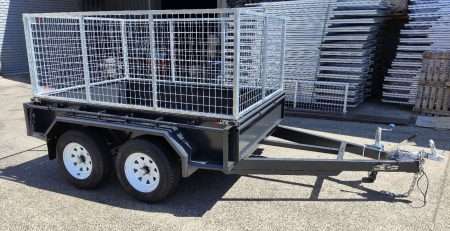The Heart of Cooling: Understanding Engine Cooling System Components
Essential Components of Engine Cooling
Understanding the core components of your vehicle’s cooling system can help you maintain its efficiency and longevity. We’ll discuss three crucial parts in this section: the radiator, the thermostat, and the water pump.
Role of the Radiator
The radiator is one of the most visible parts of a vehicle’s engine cooling system. A radiator’s primary function is to dissipate the heat that the coolant absorbs from the engine. This process, in turn, helps to maintain the engine at a safe operating temperature, thereby preventing overheating.
The radiator is made up of a series of tubes and fins that enhance the dissipation of heat. As coolant passes through the radiator, the heat it carries is released into the ambient air, cooling the liquid before it returns to the engine to collect more heat.
Function of the Thermostat
A thermostat in an engine cooling system serves a critical role in regulating the flow of coolant to the engine based on its operating temperature. This regulation helps keep the engine at the optimal temperature for efficient operation.
The thermostat acts as a valve that controls the flow of coolant between the engine and the radiator. It opens and closes in response to the engine’s temperature, thereby maintaining optimal operating conditions (Cochran Cars). For more information on thermostat maintenance and replacement, check out our guide on engine thermostat replacement.
Importance of the Water Pump
The water pump is another crucial component of an engine’s cooling system. Its primary function is to circulate coolant throughout the engine, preventing overheating and maintaining an optimal operating temperature (NTB Tyre & Service Centres).
Usually, a belt connected to the engine’s crankshaft powers the water pump. As the crankshaft rotates, it spins the water pump impeller, thereby creating the flow of coolant (NTB Tyre & Service Centers). If the water pump fails, it can lead to an engine coolant leak or, worse, engine overheating.
Understanding these critical components of an engine’s cooling system is vital to maintaining your vehicle’s health. Regular checks and maintenance of these parts can prevent potential damage and costly repairs. For a complete list of engine cooling system parts, refer to our detailed guide on engine cooling system parts.
Delving into Cooling System Parts
Beyond the radiator, water pump, and thermostat, the engine cooling system contains other essential components that play a vital role in maintaining the engine’s temperature. In this section, we will delve into the specifics of the cooling system hoses and the cooling fan.
Understanding Hoses
The hoses in an engine cooling system serve a significant purpose: they connect the various components of the cooling system, allowing coolant to flow between them. They are typically made of rubber or silicone and are designed to withstand high temperatures and pressure (CarParts.com).
These hoses are responsible for carrying the automotive engine coolant from the engine to the radiator for cooling and then back to the engine. This continuous circulation of coolant is essential for keeping the engine from overheating.
Despite their robust design, these hoses can deteriorate over time due to their constant exposure to heat and pressure. Any signs of swelling, cracking, or leaking can indicate an impending engine coolant leak and should be addressed immediately to prevent further damage to your automotive engine cooling system.
Mechanics of the Cooling Fan
The cooling fan is another crucial component of the engine’s cooling system. It draws in cool air through the radiator when the vehicle is at a stop or moving slowly, thereby aiding in the cooling of the engine.
Many vehicles now have electric cooling fans that operate only when necessary, based on the engine coolant temperature climbing above a certain point. This change was made for packaging reasons in front-wheel-drive (FWD) vehicles with transversely mounted engines, where traditional belt-driven fans were not feasible.
The use of electric cooling fans can improve fuel economy by reducing the overall load on the engine during most driving conditions. This is why even many rear-wheel-drive (RWD) vehicles now use electric cooling fans.
Understanding the mechanics of your engine cooling system components can help you diagnose problems and perform timely maintenance. Regular checks and replacements can prevent severe damage and ensure the long-term health of your engine. For more information, check out our resources on engine cooling system repair.
Maintaining Your Cooling System
To ensure the efficient operation of your vehicle, it’s crucial to conduct regular maintenance on the engine cooling system components. This includes the water pump, one of the most critical parts of the system, as well as the hoses that transport coolant throughout the engine.
Recognising Water Pump Failure
The water pump is a key component of the automotive engine cooling system. Its main function is to circulate coolant throughout the engine to prevent overheating and maintain optimal operating temperature (NTB Tyre & Service Centres).
Failure of the water pump can lead to serious damage, including engine failure. It’s essential to be aware of the signs of a failing water pump to prevent such an issue. These signs may include coolant leaks, excessive engine heat, and steam coming from the radiator. If you notice any of these signs, it’s crucial to have your water pump inspected and replaced if necessary. For more information on recognising and dealing with an engine coolant leak, visit our detailed guide.
Regular water pump maintenance
Regular maintenance of the water pump is essential for the overall health of your engine. This includes checking the coolant level, inspecting the belt that drives the water pump, flushing the cooling system, replacing the coolant, inspecting the water pump and hoses for leaks, and removing any debris blocking the coolant flow.
It is recommended to replace the water pump as part of regular maintenance, typically between 60,000 and 100,000 miles, depending on the vehicle manufacturer’s recommendations. Regular coolant flushes and inspections can help identify any issues with the water pump (NTB Tyre & Service Centers). For more detailed information on engine coolant replacement and engine coolant flushing, check out our guides.
Inspecting and replacing hoses
The hoses in the cooling system transport coolant to various parts of the engine. Regular inspection of these hoses is vital to ensure they are functioning properly and are not leaking. Look for signs of wear and tear, such as cracks or bulges, and replace any damaged hoses immediately to prevent coolant leaks and potential engine damage.
By taking the time to maintain your cooling system regularly, you can prevent expensive repairs and extend the life of your engine. For more detailed information on engine cooling system repair, consult our comprehensive guide.
The Impact of Cooling Systems
Beyond their essential role in regulating an engine’s temperature, cooling systems also have significant implications for fuel economy and overall engine health. In this section, we will delve into the connection between cooling systems and fuel economy, how they contribute to engine health, and the potential consequences of cooling system failure.
Cooling Systems and Fuel Economy
Advancements in cooling systems, particularly the shift from belt-driven fans to electric cooling fans, have resulted in improved fuel economy. Many vehicles, especially those with front-wheel drive (FWD) and transversely mounted engines, now have electric cooling fans that operate only when necessary based on the engine coolant temperature climbing above a certain point. This change was made for packaging reasons, where traditional belt-driven fans were not feasible (MACS Worldwide).
Electric cooling fans reduce the overall load on the engine during most driving conditions, which in turn improves fuel economy. This is why even many rear-wheel-drive (RWD) vehicles now use electric cooling fans. However, some RWD vehicles, particularly trucks, still use belt-driven engine cooling fans equipped with a thermostatic fan clutch. The fan clutch allows the fan to spin with reduced force when full cooling demand is not needed, thereby enhancing fuel economy.
Engine health and cooling systems
The components of an automotive engine cooling system work together to regulate the engine’s temperature, preventing overheating and promoting engine longevity. The radiator, water pump, thermostat, hoses, and fan are the main parts, according to CarParts.com. The radiator transfers heat from the coolant to the surrounding air, the water pump circulates coolant through the engine and radiator, and the thermostat regulates coolant flow based on the engine’s temperature.
Potential Consequences of Cooling System Failure
Failure in any of the engine cooling system components can lead to serious consequences, including engine overheating. For instance, electric cooling fans can fail to activate if there is an issue with the thermostatic switch, sensor, or relay, which can lead to engine overheating. Diagnosing such failures may require special electronic diagnostic tools.
Similarly, thermostatic fan clutches can wear out over time, and their failure may go unnoticed until the vehicle is subjected to severe operating conditions. Regular inspections and tests performed by a service technician can determine if the fan clutch is operating properly (MACS Worldwide).
In conclusion, the importance of a well-functioning cooling system cannot be overstated. Regular maintenance and timely repair of the cooling system components are necessary to maintain fuel economy, ensure engine health, and prevent the potential consequences of system failure. For assistance with maintaining or repairing your cooling system, consider our engine cooling system repair services.
Author
I am Rahatul Ashiq Tamal. Another author of Muscle Trailers. Muscle Trailers is a well-known trailer brand in Sydney, Melbourne & Adelaide

How to Mount a Spare Tire on Your Trailer: A Simple Step-by-Step Guide
Trailer service centers receive over 1 million phone calls and 1.3 million emails each year about trailer maintenance problems....

How to Fix RV Roof Leaks: Simple Roof Leak Detection Guide for Beginners
Did you know DIY RV roof repairs can cost under $50? But undetected leaks could lead to substantially higher repair...

Starting a Food Truck Business in Australia: From Trailer Selection to Launch
The Australian mobile food market has evolved into a billion-dollar industry. This makes a food truck...
